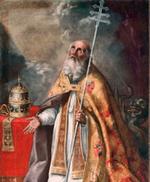Cardinal explains Pope Francis’s ‘equivalent canonization’ of St. Peter Faber
December 24, 2013
In an interview published in L’Osservatore Romano, the prefect of the Congregation for the Causes of Saints discussed Pope Francis’s recent equivalent canonization of St. Peter Faber (1506-46), one of the first Jesuits.
In equivalent canonization – a procedure described by Pope Benedict XIV in the eighteenth century – the Pope waives the usual judicial process and declares that a blessed’s liturgical cult is extended to the universal Church. Pope Benedict canonized St. Hildegard of Bingen (1098-1179) by equivalent canonization in 2012, and Pope Francis had earlier canonized St. Angela of Foligno (1248-1309) by equivalent canonization in October.
“Equivalent canonization, though not frequent, is not rare in the Church,” said Cardinal Angelo Amato. “The best known are Gregory VII, Gertrude of Helfta, Peter Damian, Cyril and Methodius, John Damascene, the Venerable Bede, Albert the Great, Thomas More, John of Avila.”
Cardinal Amato said that three elements are necessary for an equivalent canonization: a long-time cult, the “constant and common attestation” of credible historians on the blessed’s virtues, and an “uninterrupted reputation for wonders” obtained through the blessed’s intercession. All three, said the prelate, were present in St. Peter Faber’s case.
Faber, noted Cardinal Amato, was distinguished by his obedience, humility, and devotion to the guardian angels. Blessed Pius IX beatified Faber in 1872.
For all current news, visit our News home page.
Further information:
- La virtù di perdere tempo (L’Osservatore Romano)
- Vatican approval of miracle paves way for beatification of American nun (CWN, 12/20)
- Waiving Vatican routines, Pope to declare sainthood of Peter Faber (CWN, 12/17)
All comments are moderated. To lighten our editing burden, only current donors are allowed to Sound Off. If you are a current donor, log in to see the comment form; otherwise please support our work, and Sound Off!







